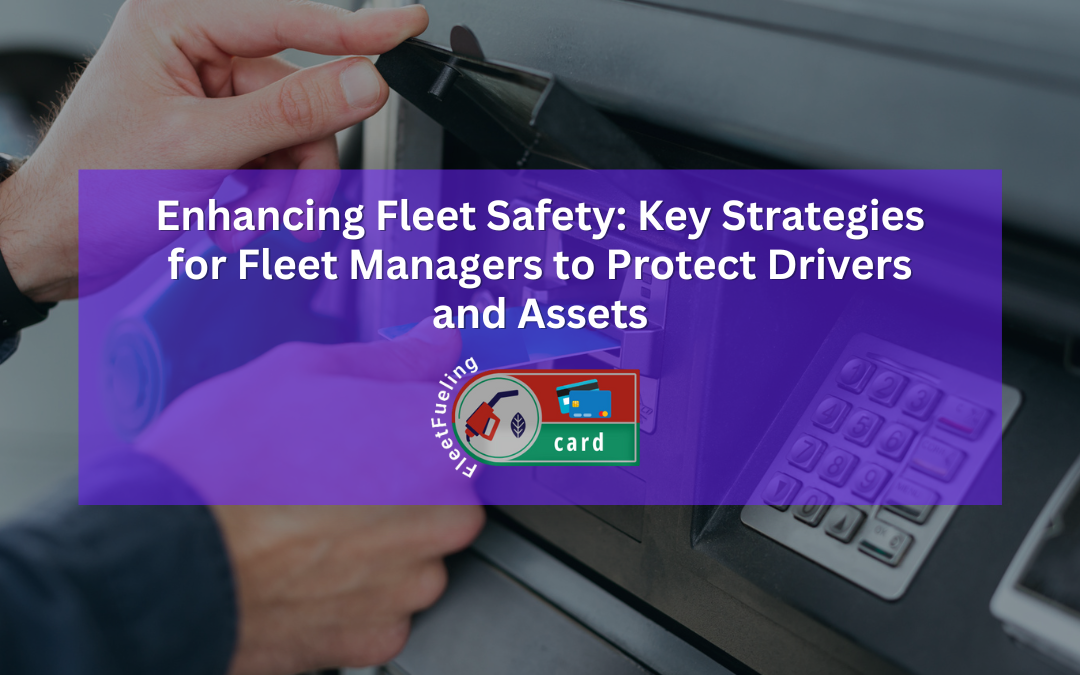Fleet safety is a top priority for fleet managers who are responsible for ensuring that their vehicles, drivers, and cargo are protected from accidents and other risks. The safety of the fleet has direct implications not only for the wellbeing of drivers and other road users but also for the bottom line of the business. Accidents can lead to significant costs in the form of repairs, insurance premiums, liability claims, and downtime, as well as damage to the company’s reputation.
In this article, we will explore critical strategies that fleet managers can implement to enhance fleet safety. From adopting advanced safety technologies to providing driver training and maintaining vehicle health, we will provide a comprehensive guide on how to safeguard fleet operations while improving overall efficiency and compliance.
Why Fleet Safety Should Be a Top Priority for Fleet Managers
Fleet safety goes beyond avoiding accidents; it is about ensuring that the fleet operates efficiently while minimizing risks. Accidents not only disrupt operations but can also lead to severe financial penalties, legal issues, and long-term damage to the company’s reputation. For fleet managers, ensuring safety is an ongoing responsibility that requires constant attention and proactive measures.
In addition to the immediate costs associated with accidents, including repairs and medical expenses, there are indirect costs such as increased insurance premiums, legal fees, and potential loss of customers due to negative perceptions. Moreover, ensuring the safety of drivers is essential for maintaining high morale and reducing turnover rates. The more a company invests in fleet safety, the more likely it is to experience a positive return in terms of employee satisfaction, operational efficiency, and reduced risks.
Improving fleet safety not only protects people and assets but also helps to maintain legal compliance with safety regulations, reducing the likelihood of fines and penalties. In many industries, fleet safety is not just a moral responsibility; it’s a legal one as well. By implementing proactive safety strategies, fleet managers can create a culture of safety that benefits both employees and the company.
Key Strategies to Improve Fleet Safety
-
Leverage Advanced Safety Technologies
One of the most effective ways to enhance fleet safety is through the adoption of advanced safety technologies. Today’s fleet vehicles are equipped with a wide range of safety features designed to help prevent accidents and reduce risks on the road. Some of the most common safety technologies include:
- Collision Avoidance Systems: These systems use sensors and cameras to detect obstacles, warn drivers of potential collisions, and even apply the brakes in emergency situations.
- Lane Departure Warning: This system alerts drivers if they are unintentionally drifting out of their lane, helping to prevent accidents caused by driver fatigue or distraction.
- Blind Spot Monitoring: This technology provides drivers with alerts when another vehicle is in their blind spot, reducing the likelihood of side-impact collisions.
- Electronic Stability Control: This system helps prevent skidding and loss of control during dangerous driving conditions by automatically adjusting the vehicle’s braking and engine power.
By investing in these technologies, fleet managers can significantly reduce the risk of accidents caused by human error or environmental factors. Moreover, advanced safety features can be particularly beneficial in protecting drivers, reducing the likelihood of serious injury in the event of an accident.
-
Implement Driver Training and Safety Programs
Driver behavior is one of the most significant factors affecting fleet safety. Even with the latest safety technologies in place, poor driving habits such as speeding, tailgating, and distracted driving can increase the likelihood of accidents. To mitigate these risks, fleet managers should implement comprehensive driver safety training programs.
Driver training should cover a wide range of topics, including:
- Defensive Driving: Teaching drivers to anticipate potential hazards and react appropriately in emergency situations can help reduce accidents.
- Safe Speeding and Following Distance: Drivers should be educated on the importance of adhering to speed limits and maintaining a safe distance from other vehicles, particularly in adverse weather conditions.
- Avoiding Distractions: Encouraging drivers to stay focused on the road and avoid distractions, such as mobile phones or in-cab technology, can help prevent accidents caused by inattention.
- Fatigue Management: Educating drivers on the dangers of driving while tired and encouraging regular breaks can help reduce accidents caused by drowsiness.
Training programs should be ongoing and include periodic refresher courses to reinforce safe driving practices. Fleet managers can also use telematics and GPS data to monitor driver behavior in real-time, providing feedback and coaching to drivers who need improvement.
-
Maintain Regular Vehicle Inspections and Preventive Maintenance
A fleet’s safety largely depends on the condition of the vehicles. Regular inspections and preventive maintenance are essential to ensure that fleet vehicles remain in top working order, minimizing the risk of breakdowns and accidents caused by vehicle malfunction.
Routine maintenance tasks should include checking critical safety components such as brakes, tires, lights, and steering systems. Fleet managers should create a scheduled maintenance plan for each vehicle based on manufacturer recommendations and usage patterns. Using fleet management software can help managers track maintenance schedules, ensuring that no vehicle misses an important inspection or service.
In addition to regular inspections, fleet managers should prioritize the replacement of old or worn-out parts, such as tires or batteries, before they pose a safety risk. Keeping track of vehicle health and addressing issues before they become major problems can prevent accidents caused by mechanical failures.
-
Use Fleet Telematics for Monitoring and Safety Analytics
Telematics systems provide fleet managers with real-time data about vehicle performance, location, speed, and driver behavior. By utilizing this data, fleet managers can identify potential safety risks and take corrective action before accidents occur.
For example, telematics systems can monitor speeding, harsh braking, rapid acceleration, and sudden lane changes, all of which can indicate risky driving behavior. Fleet managers can use this data to provide feedback to drivers, offering coaching and training where necessary to encourage safer driving habits.
Telematics systems can also track vehicle health and maintenance needs. If a vehicle is showing signs of wear or malfunction, the system can alert fleet managers to take action before the issue becomes a safety concern.
By leveraging telematics data, fleet managers can gain valuable insights into safety performance across the entire fleet, allowing them to proactively address any issues and improve overall fleet safety.
-
Implement a Clear Safety Policy and Promote a Safety Culture
Creating a safety-conscious culture within the organization is essential for ensuring that all employees understand the importance of safety and follow best practices. Fleet managers should develop a clear safety policy that outlines the company’s expectations regarding driver behavior, vehicle maintenance, and safety protocols.
This policy should be communicated to all employees and regularly reviewed to ensure that it aligns with the latest safety regulations and best practices. In addition to the policy, fleet managers should create a system for reporting safety hazards, accidents, or near-misses. By encouraging employees to report potential risks, fleet managers can take immediate action to prevent accidents before they occur.
Promoting a culture of safety involves more than just implementing rules—it’s about making safety a core value of the organization. Fleet managers should recognize and reward safe driving behavior, celebrate milestones in safety achievements, and encourage open communication about safety concerns.
Building a Safe and Efficient Fleet for the Long-Term
Fleet safety is a crucial aspect of fleet management that cannot be overlooked. By implementing the right technologies, training programs, and maintenance practices, fleet managers can significantly reduce the risk of accidents, protect drivers, and ensure that vehicles are operating safely and efficiently.
Investing in advanced safety technologies, such as collision avoidance systems and lane departure warnings, can reduce accidents caused by human error. Additionally, ongoing driver training, regular vehicle inspections, and the use of telematics to monitor performance are essential for maintaining fleet safety.
A proactive approach to safety not only protects employees and assets but also helps businesses save on insurance premiums, reduce downtime, and improve overall fleet performance. Fleet managers who prioritize safety can create a culture of responsibility that contributes to the long-term success and profitability of their fleet operations. By combining technology, training, and a commitment to safety, fleet managers can ensure that their fleet operates safely and effectively on the road.


**mindvault**
mindvault is a premium cognitive support formula created for adults 45+. It’s thoughtfully designed to help maintain clear thinking
**prostadine**
prostadine is a next-generation prostate support formula designed to help maintain, restore, and enhance optimal male prostate performance.
**sugarmute**
sugarmute is a science-guided nutritional supplement created to help maintain balanced blood sugar while supporting steady energy and mental clarity.
**glpro**
glpro is a natural dietary supplement designed to promote balanced blood sugar levels and curb sugar cravings.
**zencortex**
zencortex contains only the natural ingredients that are effective in supporting incredible hearing naturally.
**mitolyn**
mitolyn a nature-inspired supplement crafted to elevate metabolic activity and support sustainable weight management.
**prodentim**
prodentim an advanced probiotic formulation designed to support exceptional oral hygiene while fortifying teeth and gums.
**yusleep**
yusleep is a gentle, nano-enhanced nightly blend designed to help you drift off quickly, stay asleep longer, and wake feeling clear.
**vitta burn**
vitta burn is a liquid dietary supplement formulated to support healthy weight reduction by increasing metabolic rate, reducing hunger, and promoting fat loss.
**synaptigen**
synaptigen is a next-generation brain support supplement that blends natural nootropics, adaptogens
**nitric boost**
nitric boost is a dietary formula crafted to enhance vitality and promote overall well-being.
**glucore**
glucore is a nutritional supplement that is given to patients daily to assist in maintaining healthy blood sugar and metabolic rates.
**wildgut**
wildgutis a precision-crafted nutritional blend designed to nurture your dog’s digestive tract.
**pinealxt**
pinealxt is a revolutionary supplement that promotes proper pineal gland function and energy levels to support healthy body function.
**energeia**
energeia is the first and only recipe that targets the root cause of stubborn belly fat and Deadly visceral fat.
**boostaro**
boostaro is a specially crafted dietary supplement for men who want to elevate their overall health and vitality.
**prostabliss**
prostabliss is a carefully developed dietary formula aimed at nurturing prostate vitality and improving urinary comfort.
**potentstream**
potentstream is engineered to promote prostate well-being by counteracting the residue that can build up from hard-water minerals within the urinary tract.
**breathe**
breathe is a plant-powered tincture crafted to promote lung performance and enhance your breathing quality.
**hepatoburn**
hepatoburn is a premium nutritional formula designed to enhance liver function, boost metabolism, and support natural fat breakdown.
**hepato burn**
hepato burn is a potent, plant-based formula created to promote optimal liver performance and naturally stimulate fat-burning mechanisms.
**cellufend**
cellufend is a natural supplement developed to support balanced blood sugar levels through a blend of botanical extracts and essential nutrients.
**prodentim**
prodentim is a forward-thinking oral wellness blend crafted to nurture and maintain a balanced mouth microbiome.
**flow force max**
flow force max delivers a forward-thinking, plant-focused way to support prostate health—while also helping maintain everyday energy, libido, and overall vitality.
**neuro genica**
neuro genica is a dietary supplement formulated to support nerve health and ease discomfort associated with neuropathy.
**revitag**
revitag is a daily skin-support formula created to promote a healthy complexion and visibly diminish the appearance of skin tags.
**sleeplean**
sleeplean is a US-trusted, naturally focused nighttime support formula that helps your body burn fat while you rest.
**memorylift**
memorylift is an innovative dietary formula designed to naturally nurture brain wellness and sharpen cognitive performance.
The clarity here is outstanding.